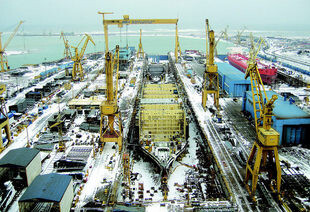hankyoreh
Links to other country sites 다른 나라 사이트 링크
S. Korean shipyards outperform rivals

South Korean shipbuilders are cruising fast in global markets, chalking up as much as US$30 billion worth of orders in the first half of this year and the largest ever for a six-month period. Against the unprecedented pace of growth, however, some have raised concerns that the lack of a skilled workforce and materials could come as a challenge confronting the shipbuilding industry further down the road, underscoring the need to step up efforts to brace for changing business conditions.
According to the Ministry of Commerce, Industry and Energy and other industrial data, local shipyards obtained orders to build a total of 364 ships worth $33.2 billion during the first six months of this year, up 38.2 percent from a year earlier. They have a backlog of 1,346 ships to build, which will keep them busy for the next four years.
South Korean shipyards are outperforming their rivals not just in the number of orders, but also in the number requests for high-end ships. They had obtained orders to build 14 drill ships and 13 LNG ships during the first half of the year. Ships built to carry LNG, or liquefied natural gas, cost more than $200 billion.
Profitability has also improved. According to the data, the average price of ships to be built reached $2,933 per CGT, or compensated gross ton, up 28.4 percent a year earlier. Reflecting the robust business performance, shipyard shares have become the new blue chips in the Seoul bourse.
For their parts, local shipyards are employing innovative shipbuilding methods and expanding facility investment to meet the deadline.
As the global shipbuilding industry is enjoying brisk business, mid-sized local shipyards are also rushing to expand facility investment in a bid to emerge as the world’s leading players. Sungdong Shipbuilding & Marine Engineering and SPP Shipbuilding jumped to the global list of top 20 shipyards last year by obtaining their own shipbuilding facilities. As many as 20 others in the Shipbuilding Industrial Complex in Goseong, South Kyeongsang Province, alone are working to simulate the two companies’ success.
Such seemingly heavy facility investment within the industry is, however, causing some market observers to raise concerns that it could lead to an oversupply and eventually prompt prices to drop. At a seminar held in Seoul, Hong Seong-in, a researcher at the Korea Institute for Industrial Economics and Trade, warned that an oversupply prompted by Chinese shipyards could lead to red-hot competition, price drops, a reduction in order-taking and lack of workers, thus causing delays in supplying ships to clients.
In particular, the possible lack of skilled workers could come as a serious challenge for local shipyards. The Korea Shipbuilders’ Association said that the local shipbuilding industry will suffer a labor shortage of 2,000 workers a year over the next three years. If the business cycle goes south, local shipbuilders could face downward pressure to trim their payrolls. Hong said Japan and European shipyards suffered this kind of challenge in the 1970s, and were forced to cut workers by 60-78 percent and 70 percent, respectively.
“When things get worse, the immediate impact will be felt among uncompetitive shipbuilders,” Hong said. “To survive, latecomers should be able to design on their own and step up research and development efforts, while working on cutting costs and improving competitiveness.”
Editorial・opinion
![[Column] Season 2 of special prosecutor probe may be coming to Korea soon [Column] Season 2 of special prosecutor probe may be coming to Korea soon](https://flexible.img.hani.co.kr/flexible/normal/500/300/imgdb/original/2024/0426/3317141030699447.jpg) [Column] Season 2 of special prosecutor probe may be coming to Korea soon
[Column] Season 2 of special prosecutor probe may be coming to Korea soon![[Column] Park Geun-hye déjà vu in Yoon Suk-yeol [Column] Park Geun-hye déjà vu in Yoon Suk-yeol](https://flexible.img.hani.co.kr/flexible/normal/500/300/imgdb/original/2024/0424/651713945113788.jpg) [Column] Park Geun-hye déjà vu in Yoon Suk-yeol
[Column] Park Geun-hye déjà vu in Yoon Suk-yeol- [Editorial] New weight of N. Korea’s nuclear threats makes dialogue all the more urgent
- [Guest essay] The real reason Korea’s new right wants to dub Rhee a founding father
- [Column] ‘Choson’: Is it time we start referring to N. Korea in its own terms?
- [Editorial] Japan’s rewriting of history with Korea has gone too far
- [Column] The president’s questionable capacity for dialogue
- [Column] Are chaebol firms just pizza pies for families to divvy up as they please?
- [Column] Has Korea, too, crossed the Rubicon on China?
- [Correspondent’s column] In Japan’s alliance with US, echoes of its past alliances with UK
Most viewed articles
- 1[Column] Season 2 of special prosecutor probe may be coming to Korea soon
- 2‘We must say no’: Seoul defense chief on Korean, USFK involvement in hypothetical Taiwan crisis
- 3Division commander ordered troops to enter raging flood waters before Marine died, survivor says
- 4Is N. Korea threatening to test nukes in response to possible new US-led sanctions body?
- 5Is Japan about to snatch control of Line messenger from Korea’s Naver?
- 6No good, very bad game for Korea puts it out of Olympics for first time since 1988
- 7[Editorial] Korea’s surprise Q1 growth requires objective assessment, not blind fanfare
- 8Korea’s 1.3% growth in Q1 signals ‘textbook’ return to growth, says government
- 9N. Korean delegation’s trip to Iran shows how Pyongyang is leveraging ties with Moscow
- 10Amnesty notes ‘erosion’ of freedom of expression in Korea in annual human rights report